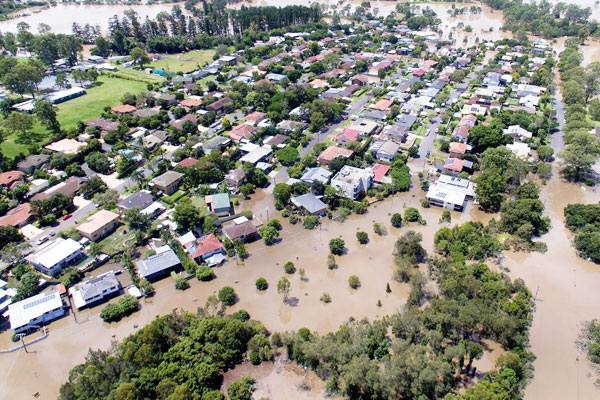Australians’ well-documented affinity with the sun, surf and sand continue to fuel coastal property market growth.
This growth defies rising interest rates and growing evidence of the impacts of climate change on people living in vulnerable coastal locations.

People in these areas are finding it harder to insure their properties against these risks.
Insurers view the Australian market as sensitive to climate risks, as climate change impacts can trigger large insurance payouts.
They are pricing their products accordingly.
Clearly, there is a vast disconnect between the coastal property market and climate change impacts such as increasingly severe storms, tidal surges, coastal erosion and flooding.
There is no shortage of reports, studies and analyses confirming the climate risks we are already living with.
Yet another alarming State of the Climate report was released last week.
We keep talking about reaching global net-zero emissions.
But this “blah blah blah” masks the fact that climate impacts are already with us.
Even if we make deeper, faster cuts to emissions, as we must, our world is now warmer.
Australians will feel the effects of that warming.
We ultimately cannot afford the price of business as usual, as embodied by so many coastal developments.
Risks are worrying banks and insurers
In Australia, the disasters and the environmental collapse we are experiencing will get worse.
While a range of businesses sees this as opening up a new market and product frontiers, the fact is climate change is creating a fundamentally uncertain, unstable and difficult world.
Banks have a central role in addressing climate risks.
They are exposed to climate risk through residential lending on properties that are vulnerable to climate impacts and now face insurance pressures.
One in 25 Australian homes are projected to be uninsurable by 2030.

The Australian government risks bearing the large costs of supporting the underinsured or uninsured – otherwise known as being “the insurer of last resort”.
This costly legacy shows why planning decisions made now must take account of climate change impacts, and not just in the wake of disasters.
The rapidly escalating impacts and risks across sectors demand that we undertake mitigation and adaptation at the same time, urgently and on a large scale.
This means reducing emissions to negative levels – not just reaching net zero and transitioning our energy sector, but also actively removing greenhouse gases from the atmosphere.
We must also respond to climate change risks already locked into the system.
We have to make substantial changes in how we think about, treat, price and act on these risks.
As the climate shifts, so must our coastal dream
The consequences of a warming climate, including reaching and crossing tipping points in the Earth’s weather systems, are occurring sooner than anticipated.
The required behavioural, institutional and structural changes are vast and challenging.
People are often attached to places based on historical knowledge of them.
These lived experiences, while important, inform a worldview based on an understanding of our environment before the rapid onset of climate change.
This can skew our climate risk responses, but compounding climate impacts are outpacing our ability to adapt as we might have in the past.
Institutional signalling, such as warnings by the Reserve Bank, supports greater public awareness of climate impacts and risks.
When buying a property, people need to consider these factors more seriously than having an extra bathroom.
Obligatory disclosure of regional climate change impacts could inform buyers’ decision-making.
The data and models used would have to be clear on the validity and limitations of their scenarios.
Nature-based and equitable solutions
In recent years there has been an increasing focus on nature-based solutions.
This approach uses natural systems and tools for tackling societal issues such as the enormous and complex risks posed by climate change.
Indeed, many Indigenous peoples, communities and ways of knowing have long recognised the fundamental role of nature in making good and safe lives possible for people.
Nature-based solutions provide a suite of valuable tools for remedying issues we’re already facing on coasts.
For example, in many contexts, building hard seawalls is often a temporary solution, which instils a false sense of security.
Planting soft barriers such as mangroves and dense, deep-rooting vegetation can provide a more enduring solution.
It also restores fish habitats, purifies water and eases floods.

Acknowledging the well-being of people and nature as interconnected has important implications for decisions about relocating people from high-risk areas.
Effectively planned retreat strategies must not only get people out of harm’s way but account for where they will move and how precious ecosystems will be protected as demand for land supply shifts.
Nature-based solutions must be built into retreat policies too.
As the Australian Academy of Science’s Strategy for Just Adaptation explains, effective adaptation also embeds equity and justice in the process.
Research on historic retreat strategies has shown that a failure to properly consider and respect people’s choices, resources and histories can further entrench inequities.

Giving people moving to a new home as much choice as possible helps them work through an emotional and highly political process.
We all need to find the courage to have difficult conversations, seek information to make prudent choices and do all we can to respond to the growing climate risks that confront us.
As climate activist Greta Thunberg says:
“Hope is not passive.
Hope is not blah blah blah.
Hope is telling the truth.
Hope is taking action.
And hope always comes from the people.”
Acting on this kind of hope can put us on an altogether different and more positive path.![]()
Guest authors are Tayanah O'Donnell, Honorary Associate Professor, Australian National University and Eleanor Robson, PhD Candidate, Institute for Culture and Society, Western Sydney University
This article is republished from The Conversation under a Creative Commons license. Read the original article here.














